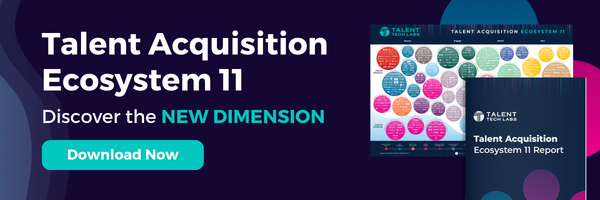This article features excerpts from the most recent Provider Insight Report, Skills Guide: Four Stages of Skills Maturity, published about skills tech and the stages of skills maturity. The below sections provide an outline of why skills data needs to be considered across the talent lifecycle and how to decipher if your organization is ready for it. While the insights showcased in this blog skim the surface, they only represent a small portion of the valuable findings in the entire Provider Insight Report, which you can find available for download here.
An organization’s ability to remain competitive and succeed in today’s increasingly digital world depends on its ability to leverage skills data across the entire talent lifecycle. By connecting data through the talent lifecycle, organizations can create a best-in-class experience for both candidates and employees. This allows them to gain valuable insights into their current and future talent needs, while also unlocking opportunities to build an adaptive workforce that is prepared for whatever the future may bring.
To truly maximize the power of skills data, organizations must assess their readiness to decipher and make use of this information. Factors such as having access to a centralized source of real-time skill insights, investing in innovative technology solutions, and creating a culture accepting of change should all be taken into consideration before transitioning to more advanced analytics approaches. With the right resources in place, organizations can ensure they have all they need to leverage skills data across their entire talent lifecycle.
Connecting data through the talent lifecycle delivers a best-in-class talent experience for candidates, employees, and alumni. The resulting talent insights can have profound implications for an adaptive workforce, particularly from skills data.
With a comprehensive, unified view of skills and competencies data, organizations can make more informed decisions across both talent acquisition and talent management. In talent acquisition, organizations can hire for potential, filling their recruiting pipelines with talent most likely to possess the skills they’ll need in the future.
This proactive hiring approach increases organizational agility by reducing time to fill critical roles. In talent management, a universal source of skills data can power upskilling, reskilling, coaching, and learning programs, in addition to guiding strategic workforce planning and internal mobility efforts.
With a comprehensive, unified view of skills and competencies data, organizations can make more informed decisions across both talent acquisition and talent management. Find out more in @TalentTechLabs’ blog: Click To TweetIf skills are the new workplace currency, it is critical for organizations to deeply understand what skills they have, what future skills they will need, and the appropriate actions to take to fill those gaps. This aspect of a comprehensive talent strategy requires skills technology (Skills Tech) and the maturation of talent data practices, including the normalization of skills and competencies data from myriad disparate sources, both internal and external. Insight into skills data from across the globe and throughout the talent lifecycle, from applicants to alumni, is then revealed. Is your organization ready?
Different Approaches to Skills Data Technology
There is a range of approaches to Skills Tech, and different vendors have taken different routes to market for their skills technologies. Some providers are even using Skills Tech as their foray into an additional area of the talent technology ecosystem.
For talent acquisition, many Candidate Relationship Management (CRM) solutions are incorporating Skills Tech into their platform. As a CRM user sources and engages with candidates, they gain visibility to skills scoring beyond keyword matching to skills inference. This yields a higher-quality pipeline of candidates. Aside from the job description, however, this is somewhat disconnected from the skills information inside the organization.
Multiple solution areas within talent management are popular and appropriate for Skills Tech. Internal Talent Marketplaces (ITMs) are quickly becoming the orchestrators of internal mobility opportunities and need skills data to intelligently match talent to new roles, projects, courses, and coaches. Learning Experience Platforms (LXPs) play a similar matchmaking role, recommending and tracking personalized learning pathways and skills are central to their utility and value.
Talent Intelligence Platforms, centralized solutions which aggregate, analyze, and visualize data about talent, wherever it is sourced, need detailed skills data to be effective. (Some of these are standalone solutions, and others are embedded in ITMs.) And, of course, core HR platforms (HRIS or HCM) have long been the trusted sources of all talent-related data, including skills. Traditional HRIS or HCM vendors are adding Skills Tech to their core offerings, perhaps hoping that platform modernization allows them to remain the trusted source of skills data.
For talent acquisition, many Candidate Relationship Management (#CRM) solutions are incorporating Skills Tech into their platform. Learn more in @TalentTechLabs’ blog: Click To TweetThe fundamental shortcoming of each of these approaches to Skills Tech is that despite the available integrations, a unified and perpetual view of an organization’s global skills posture remains absent. This creates limitations to talent decision-making across talent acquisition and talent management, including strategic workforce planning, and negatively impacts experiences throughout the talent lifecycle.
Assessing Organizational Readiness
Realizing the promise of Skills Tech requires organizational readiness, plain and simple. Many organizations adopt Skills Tech for its potential, believing that these technology investments will future-proof their talent strategy as the economy and labor market ebb and flow. Eventually, some organizations abandon it, often putting too much confidence in – and blame on – the technology itself. Properly implementing Skills Tech is no different than that of other types of technology implementations: there are many factors that influence success.
Some of the key areas where organizations typically fall short in this regard include:
Lack of strategy: The organization has not aligned its business strategy and its talent strategy. It needs to define specific goals to conduct workforce planning and, in turn, determine what skills and competencies will be needed to execute that strategy. This is the map that ensures the organization is moving towards its intended target (ROI).
Overlooking change management: It is human nature to resist change, and ignoring or even downplaying this fact gets many organizations into trouble. People need to be well prepared for changes to their familiar technologies, workflows, and terminology. This is perhaps even more true when the changes relate to people data. Clear, advanced communications, outlining what is changing and why is an important element of success.
Not understanding what it can and can’t do: Expectations must be made abundantly clear to all. Technology should be solving a prioritized business challenge. It is unrealistic to expect Skills Tech to address every current or future skills use case or to do so overnight. Make clear to all sponsors and stakeholders what use cases are in scope and the timeframe in which they will see results.
Outdated technology infrastructure: Skills Tech requires real-time data flowing to and from myriad sources. It needs scalability, reliability, security, and speed. If an organization is still using legacy platforms and infrastructure to support its operations, problems with implementation, integrations, and performance are likely to occur. Infrastructure modernization should be strongly considered to mitigate these risks.
Immature data: The benefits of Skills Tech cannot be realized if an organization’s skills data isn’t available and of a certain level of quality. Skills data can exist in many forms and in different internal and external sources. Sometimes this data can be inferred; other times, it is explicit. Before even building the business case for Skills Tech investments, organizations need to first consider the breadth and quality of their existing skills data inventory. Identifying data gaps will allow companies to chart a course along the data maturity curve and set clear goals for Skills Tech ROI.
Skills Tech can provide a powerful tool to organizations looking to future-proof their talent strategy. To ensure success, however, it is imperative that organizations consider skills data throughout the talent lifecycle and ensure their organization is ready for the deployment of Skills Tech. This includes assessing the current performance of their recruiting process, understanding the needs of their hiring teams and candidates, and having a clear set of objectives they are aiming to achieve with Skills Tech. When evaluated holistically and understood properly, Skills Tech can be a valuable asset in optimizing your organization’s talent strategy.
Thank you to Beamery for assistance with client case study information!
If your organization is looking to unlock its full potential in terms of talent management, skills data needs to be considered across the entire talent lifecycle. From job analysis and recruitment to performance review and succession planning – leveraging skills data can provide valuable insights that help organizations make better decisions. But how do you know if your organization is ready for such an endeavor?
Get the full provider insight report to discover different approaches to skills data technology, insight into a skills tech maturity framework, and more. Applying this within your organization can help guide you toward making the most informed decision possible. Download the report now to gain a detailed understanding of this subject and discover different approaches to skills data technology.

